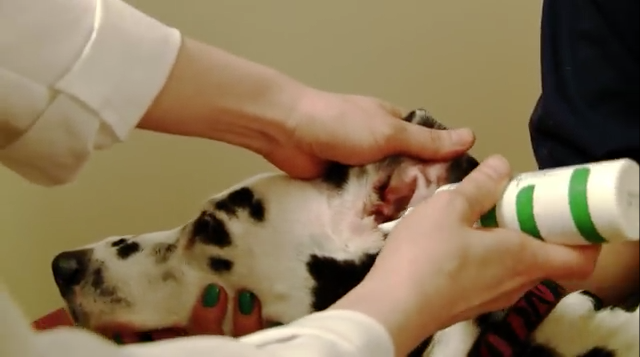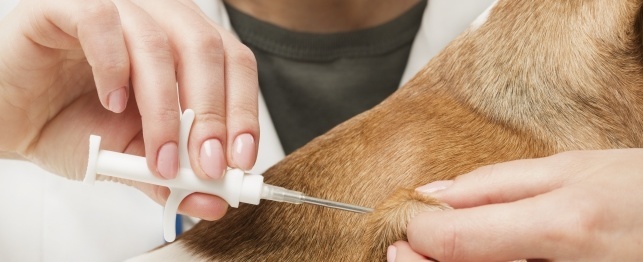
If your dog suddenly starts whining and scratching at her ears, sometimes hard enough to make them red and raw, she may have a common canine health problem—an ear infection.
There are three kinds of ear infections—otitis externa, media, and internal—affecting different parts of the canine ear. These are common conditions in dogs, especially those with floppy ears, such as Basset Hounds and Cocker Spaniels. It's estimated that about 20 percent of dogs have some form of ear disease. Here's what you need to know to reduce the incidence and severity of these painful episodes, that can affect one or both ears at a time.
Otitis externa means that the inflammation affects the layer of cells lining the outer or external portion of the ear canal. Otitis media and interna refer to infections of the middle and inner ear canal, and they are most often are a result of the spread of infection from the external ear. These more advanced cases can be very serious, and could lead to deafness, facial paralysis, or signs of vestibular disease, such as head tilting, circling, and lack of coordination. That's why it is important to prevent and seek early treatment for ear problems.
Ear canals are very sensitive, so the symptoms of infection are often clear, including:
The structure of the canine ear canal, which is more vertical than that of humans and has an "L" shape, that tends to hold in fluid. This makes dogs prone to ear problems. Some of the most common causes include:
 If your dog is showing any of the signs, it is important to visit your veterinarian as soon as possible, not only for your dog's comfort (these conditions can be extremely painful) but to also prevent spread to the middle and inner ear. Do not try to treat ear problems at home.
If your dog is showing any of the signs, it is important to visit your veterinarian as soon as possible, not only for your dog's comfort (these conditions can be extremely painful) but to also prevent spread to the middle and inner ear. Do not try to treat ear problems at home.
Be prepared to provide your vet with as thorough a history as possible. This is especially important if you have to take your dog to an emergency room, where you may be treated by a vet who has never seen you before. Ear infections can strike at any hour and can be very painful. It's not unusual, for example, for a puppy to wake up in the middle of the night, whining, head shaking and scratching her ears. So be prepared for an ER visit.
Your vet will want to know the following:
Then the vet will conduct an examination, which might require sedation, depending upon how painful the ear is and how well your dog deals with being handled. Both ears will be examined, even if only one seems to be the problem.
The exam may include:
 In the office, your vet will thoroughly clean your dog's ears and prescribe a topical medication or systemic antibiotics, that you will probably need to continue administering at home. Your vet will likely also prescribe something for pain, generally Tramadol, or steroids to ease inflammation.
In the office, your vet will thoroughly clean your dog's ears and prescribe a topical medication or systemic antibiotics, that you will probably need to continue administering at home. Your vet will likely also prescribe something for pain, generally Tramadol, or steroids to ease inflammation.
You may also have to clean your dog's ears, but usually after the first recheck, which is generally in five to seven days.
Uncomplicated cases can take about 10 to 30 days to resolve. But some may take months, and others may be chronic.
Follow your vet's directions to the letter. Lapses in treatment might lead to a recurrence. It's extremely important to complete the full course of medication, even if it appears as if the ear looks better halfway through.
As with most diseases, prevention is always best. Learn the proper way to clean your dog's ears. If moisture is a contributing factor, make sure that you thoroughly dry ears after swimming or prevent water from getting in during baths. Cotton balls can be very useful for this purpose.
Here are some ear-cleaning guidance from Jeff Grognet, DVM, columnist for AKC Family Dog: "First, fill the canal with a cleaning solution and massage the vertical ear canal from the outside. Wipe out the canal (paper towel or cotton can leave irritating fibers behind) with absorbent gauze. Don't use paper towels or cotton because these may leave fibers behind, and those could cause an irritation.
Cotton-tipped sticks may be useful in cleaning the folds on your dog’s ear flap, but don’t use them in the ear canal. You might inadvertently push debris deeper into the canal and pack it at the bottom.
This video from Colorado State University offers some instruction on cleaning and medicating a dog's ears.
Sources include the Merck Veterinary Manual and Colorado State University College of Veterinary Medicine and Biomedical Sciences.

Did you know that having a regular tooth brushing routine can have a major impact on your dog's health? Download this e-book to learn more.
Get Free Download Now Microchipping for Your Dogs Safety
Microchipping for Your Dogs Safety
Microchipping for Your Dogs Safety
Microchipping for Your Dogs Safety
 Can Dogs Eat Watermelon?
Everybody loves watermelon, even
Can Dogs Eat Watermelon?
Everybody loves watermelon, even
 How to Care for a Cut Wound on a Dog's Paw
How to Care for a Cut Wound on a Dog's Pa
How to Care for a Cut Wound on a Dog's Paw
How to Care for a Cut Wound on a Dog's Pa
 Metronidazole For Dogs: What it is Used for and Guidelines for Safety
Dog owners today are armed with mor
Metronidazole For Dogs: What it is Used for and Guidelines for Safety
Dog owners today are armed with mor
 The Dangers of Picnics and Parties
The Dangers of Picnics and Parties to Dogs
The Dangers of Picnics and Parties
The Dangers of Picnics and Parties to Dogs
Copyright © 2005-2016 Pet Information All Rights Reserved
Contact us: www162date@outlook.com